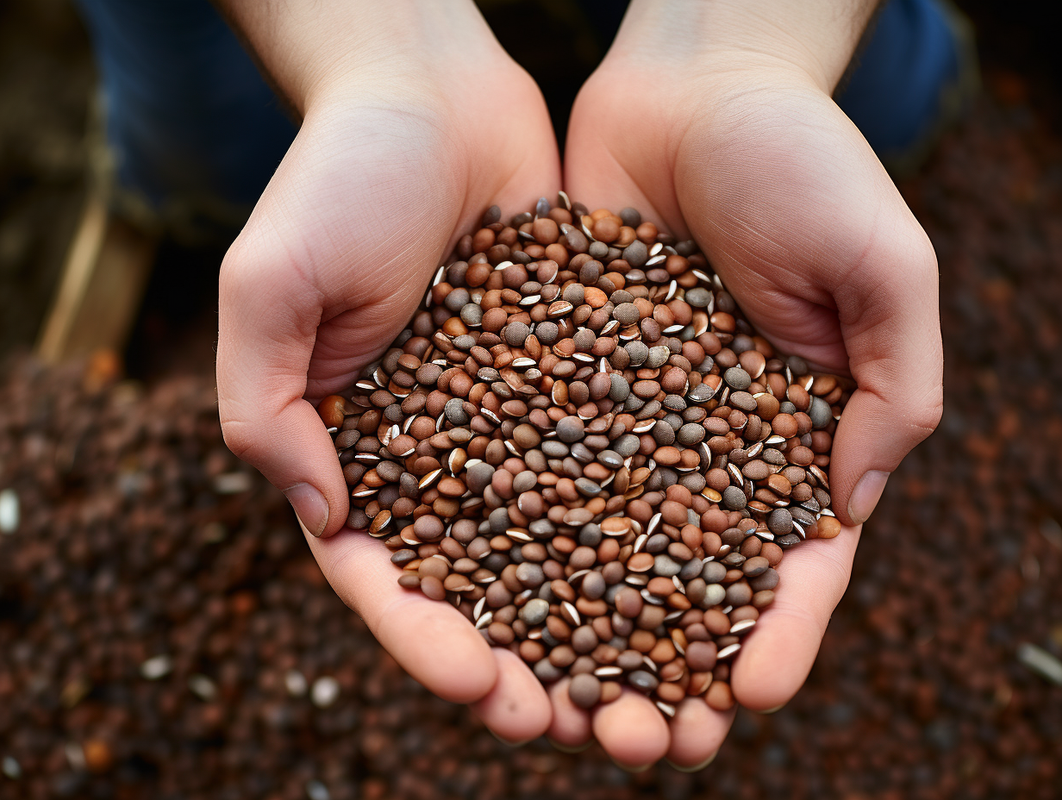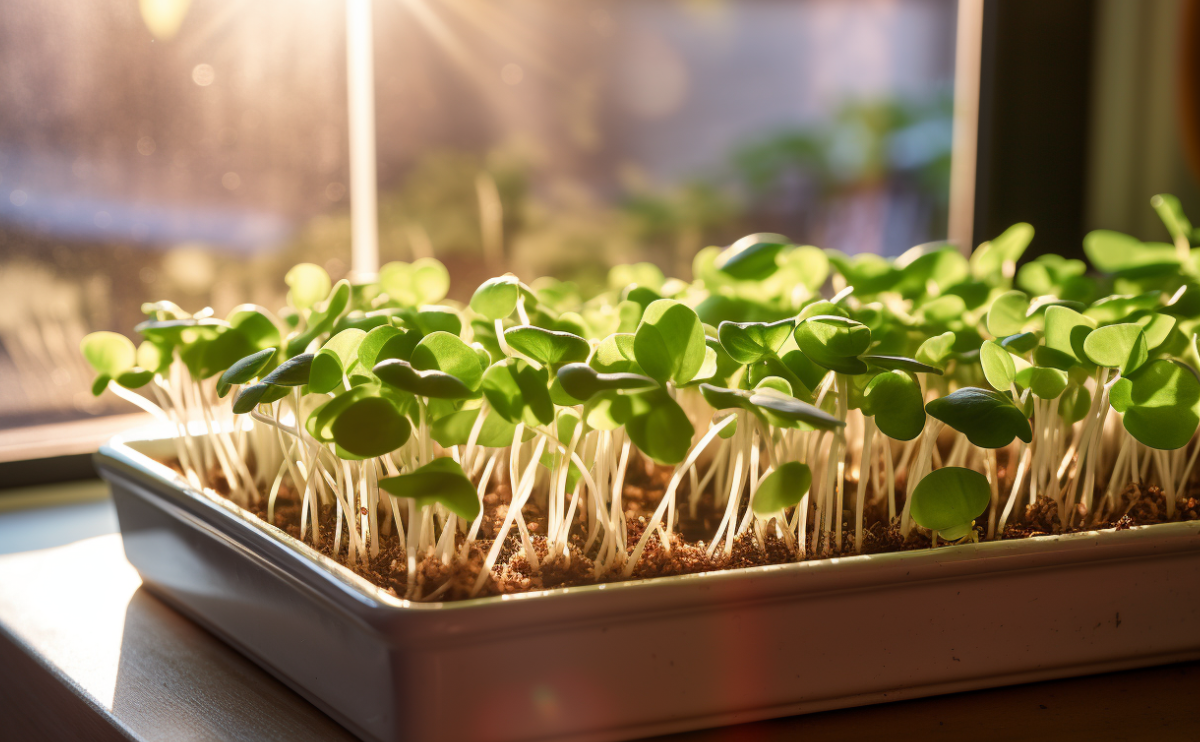Microgreens, with their burst of flavor and nutritional punch, have become a favorite among chefs and home cooks alike. These tiny greens, harvested just as their first leaves emerge, offer a unique blend of taste, texture, and visual appeal. But why limit their charm to professional kitchens? With a touch of dedication and the right techniques, you can cultivate these green wonders in the comfort of your home. This guide aims to be your comprehensive companion, providing insights, tips, and techniques to help you establish a thriving indoor garden. By the end, you’ll have all the knowledge you need to grow a vibrant array of microgreens, turning every meal into a gourmet experience.
Delving Deeper into Microgreens and Heirloom Seeds
The Magic of Microgreens
Microgreens are more than just a culinary trend; they’re a revolution in the way we approach food. These young vegetable greens, harvested shortly after the cotyledon leaves have developed, are a powerhouse of nutrition. They often contain higher concentrations of vitamins, minerals, and antioxidants compared to their mature counterparts. This makes them not just a delightful addition to dishes but also a significant health booster. From adding a spicy kick with radish microgreens to a sandwich, to garnishing a gourmet dish with delicate basil shoots, they offer versatility in the kitchen. Beyond their taste, they’re also a visual treat, adding vibrant colors and textures to dishes.
The Legacy of Heirloom Seeds
Heirloom seeds are a bridge to our gardening past, connecting modern gardens to age-old traditions. These seeds have been saved, shared, and sown for generations, preserving the original traits of plants. Unlike commercial hybrid seeds, heirlooms are open-pollinated, ensuring that each generation retains the characteristics of its predecessors. This means that the flavors, colors, and growth patterns remain consistent over time. When you choose to grow microgreens from heirloom seeds, you’re not just cultivating plants; you’re preserving history. The diverse range of flavors, colors, and textures they offer can turn your indoor garden into a living museum of gardening heritage.
Laying the Foundations of Your Indoor Garden
Choosing the Right Seeds
The foundation of a successful indoor microgreen garden lies in the seeds you choose. While many seeds can sprout into beautiful microgreens, heirloom varieties offer a touch of authenticity and a connection to gardening traditions. Consider what flavors and textures you’d like in your dishes. Maybe you’re after the peppery kick of radish or the subtle sweetness of pea shoots. Spend time researching and understanding the growth patterns, flavor profiles, and care requirements of different heirloom seeds. Remember, a well-thought-out seed selection can set the tone for your entire gardening experience, influencing not just the growth but also the flavors on your plate.
Soil, Planting, and Initial Care
Planting microgreens is a process that requires attention to detail. Begin with a high-quality potting mix, ensuring it offers good drainage and is free from pests or diseases. The choice of container is equally important; shallow trays or containers are ideal for microgreens. Once you’ve prepared your container, scatter your chosen heirloom seeds evenly, ensuring they have space to grow without overcrowding. A gentle press into the soil ensures they’re in contact with the moisture they need to germinate. Proper watering at this stage is crucial. A light misting provides the necessary moisture without risking waterlogged soil. Place your container in a well-lit area, and soon, you’ll witness the magic of germination and growth.

Nurturing Your Indoor Microgreen Garden
Watering, Lighting, and Growth

As your microgreens start their growth journey, their care needs evolve. While young sprouts need consistent moisture, it’s essential to strike a balance. Overwatering can lead to root rot, while underwatering can stress the plants. A spray bottle is an excellent tool for this stage, allowing for even moisture distribution. Lighting is another critical factor. While natural light from a windowsill is ideal, grow lights can supplement on cloudier days or in less sunny spaces. Regularly rotating your container ensures even growth, as all plants get equal exposure to light. With the right care, your microgreens will soon be ready for harvest, offering a fresh supply of greens right from your living space.
Harvesting, Storing, and Culinary Adventures
The culmination of your gardening efforts is the harvest. When your microgreens reach a height of a couple of inches and display their true leaves, they’re ready to be enjoyed. Using sharp scissors, cut them just above the soil, ensuring you don’t pull out the roots. While microgreens are best enjoyed fresh, if you need to store them, ensure they’re dry before placing them in a container in the refrigerator. They can stay fresh for about a week. Now, the culinary world is your oyster. From fresh salads and gourmet sandwiches to smoothies and garnishes, the ways to enjoy your home-grown microgreens are endless. Experiment, enjoy, and relish the satisfaction of eating something you’ve grown yourself.

Growing microgreens indoors is more than just a gardening activity; it’s a journey of flavors, nutrition, and connection to nature. Every step, from selecting the right heirloom seeds to the final harvest, is filled with learning and joy. As you savor the fresh taste of your home-grown microgreens, you’ll realize the true value of this endeavor. It’s not just about the greens on your plate but the sense of accomplishment, the connection to nature, and the joy of nurturing life. Embrace indoor gardening, and let every meal be a celebration of your dedication, passion, and the vibrant world of microgreens.
Detailed Guides for Planting Vegetables, Herbs, Greens & Lettuce, Peppers, and Wildflowers in Your Garden:
At FarmerValley we offer detailed guides for planting vegetables, herbs, greens & lettuce, peppers, and wildflowers. These guides provide step-by-step instructions for planting and caring for your plants, as well as tips for getting the best results. Check our growing guides and plant your own non-GMO garden with confidence.
Planting non-GMO seeds is a great way to enjoy fresh and healthy vegetables and herbs while also knowing that you’re avoiding harmful additives. With these essential tips and top lists, as well as our detailed guides, you’ll be on your way to a bountiful harvest in no time.
Elevate your gardening experience with FarmerValley’s premium seeds! Choose from our wide selection of high-quality varieties to enhance your garden and enjoy a bountiful harvest. Trust in our expertise and start your journey towards a thriving and beautiful garden today.

